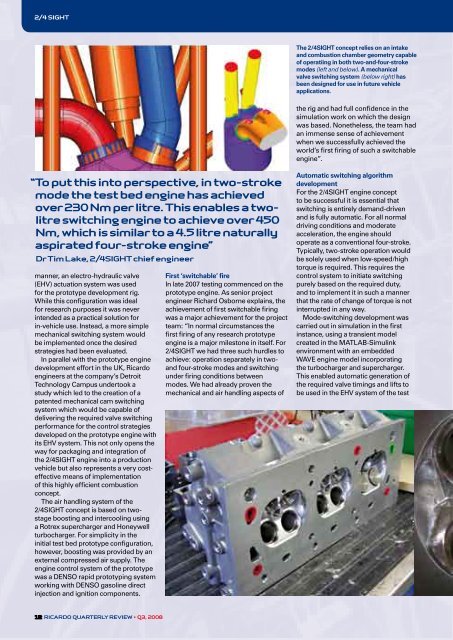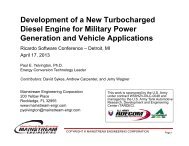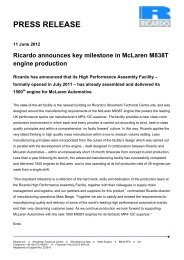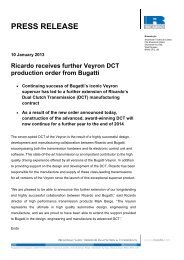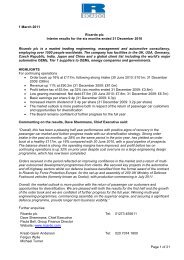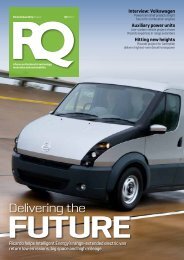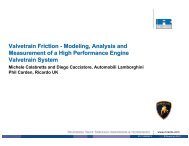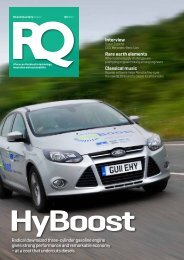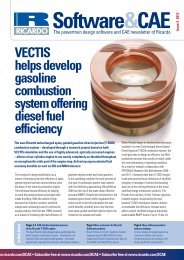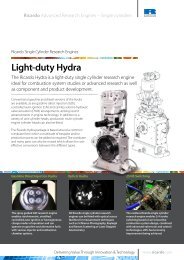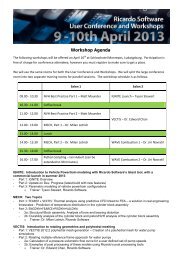Case Study - Ricardo
Case Study - Ricardo
Case Study - Ricardo
Create successful ePaper yourself
Turn your PDF publications into a flip-book with our unique Google optimized e-Paper software.
2/4 SIGHT<br />
The 2/4SIGHT concept relies on an intake<br />
and combustion chamber geometry capable<br />
of operatiing in both two-and-four-stroke<br />
modes (left and below). A mechanical<br />
valve switching system (below right) has<br />
been designed for use in future vehicle<br />
applications.<br />
the rig and had full confidence in the<br />
simulation work on which the design<br />
was based. Nonetheless, the team had<br />
an immense sense of achievement<br />
when we successfully achieved the<br />
world’s first firing of such a switchable<br />
engine”.<br />
“To put this into perspective, in two-stroke<br />
mode the test bed engine has achieved<br />
over 230 Nm per litre. This enables a twolitre<br />
switching engine to achieve over 450<br />
Nm, which is similar to a 4.5 litre naturally<br />
aspirated four-stroke engine”<br />
Dr Tim Lake, 2/4Sight chief engineer<br />
manner, an electro-hydraulic valve<br />
(EHV) actuation system was used<br />
for the prototype development rig.<br />
While this configuration was ideal<br />
for research purposes it was never<br />
intended as a practical solution for<br />
in-vehicle use. Instead, a more simple<br />
mechanical switching system would<br />
be implemented once the desired<br />
strategies had been evaluated.<br />
In parallel with the prototype engine<br />
development effort in the UK, <strong>Ricardo</strong><br />
engineers at the company’s Detroit<br />
Technology Campus undertook a<br />
study which led to the creation of a<br />
patented mechanical cam switching<br />
system which would be capable of<br />
delivering the required valve switching<br />
performance for the control strategies<br />
developed on the prototype engine with<br />
its EHV system. This not only opens the<br />
way for packaging and integration of<br />
the 2/4SIGHT engine into a production<br />
vehicle but also represents a very costeffective<br />
means of implementation<br />
of this highly efficient combustion<br />
concept.<br />
The air handling system of the<br />
2/4SIGHT concept is based on twostage<br />
boosting and intercooling using<br />
a Rotrex supercharger and Honeywell<br />
turbocharger. For simplicity in the<br />
initial test bed prototype configuration,<br />
however, boosting was provided by an<br />
external compressed air supply. The<br />
engine control system of the prototype<br />
was a DENSO rapid prototyping system<br />
working with DENSO gasoline direct<br />
injection and ignition components.<br />
First ‘switchable’ fire<br />
In late 2007 testing commenced on the<br />
prototype engine. As senior project<br />
engineer Richard Osborne explains, the<br />
achievement of first switchable firing<br />
was a major achievement for the project<br />
team: “In normal circumstances the<br />
first firing of any research prototype<br />
engine is a major milestone in itself. For<br />
2/4SIGHT we had three such hurdles to<br />
achieve: operation separately in twoand<br />
four-stroke modes and switching<br />
under firing conditions between<br />
modes. We had already proven the<br />
mechanical and air handling aspects of<br />
Automatic switching algorithm<br />
development<br />
For the 2/4SIGHT engine concept<br />
to be successful it is essential that<br />
switching is entirely demand-driven<br />
and is fully automatic. For all normal<br />
driving conditions and moderate<br />
acceleration, the engine should<br />
operate as a conventional four-stroke.<br />
Typically, two-stroke operation would<br />
be solely used when low-speed/high<br />
torque is required. This requires the<br />
control system to initiate switching<br />
purely based on the required duty,<br />
and to implement it in such a manner<br />
that the rate of change of torque is not<br />
interrupted in any way.<br />
Mode-switching development was<br />
carried out in simulation in the first<br />
instance, using a transient model<br />
created in the MATLAB-Simulink<br />
environment with an embedded<br />
WAVE engine model incorporating<br />
the turbocharger and supercharger.<br />
This enabled automatic generation of<br />
the required valve timings and lifts to<br />
be used in the EHV system of the test<br />
xxxxxx<br />
12 RICARDO QUARTERLY REVIEW • Q3, 2008


